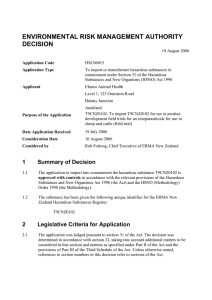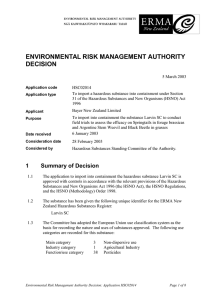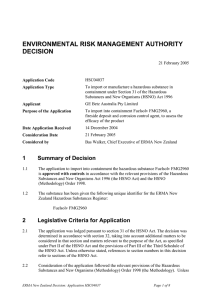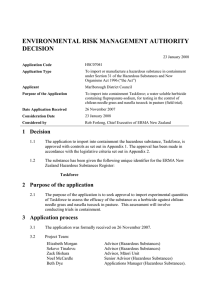ENVIRONMENTAL RISK MANAGEMENT AUTHORITY DECISION
advertisement
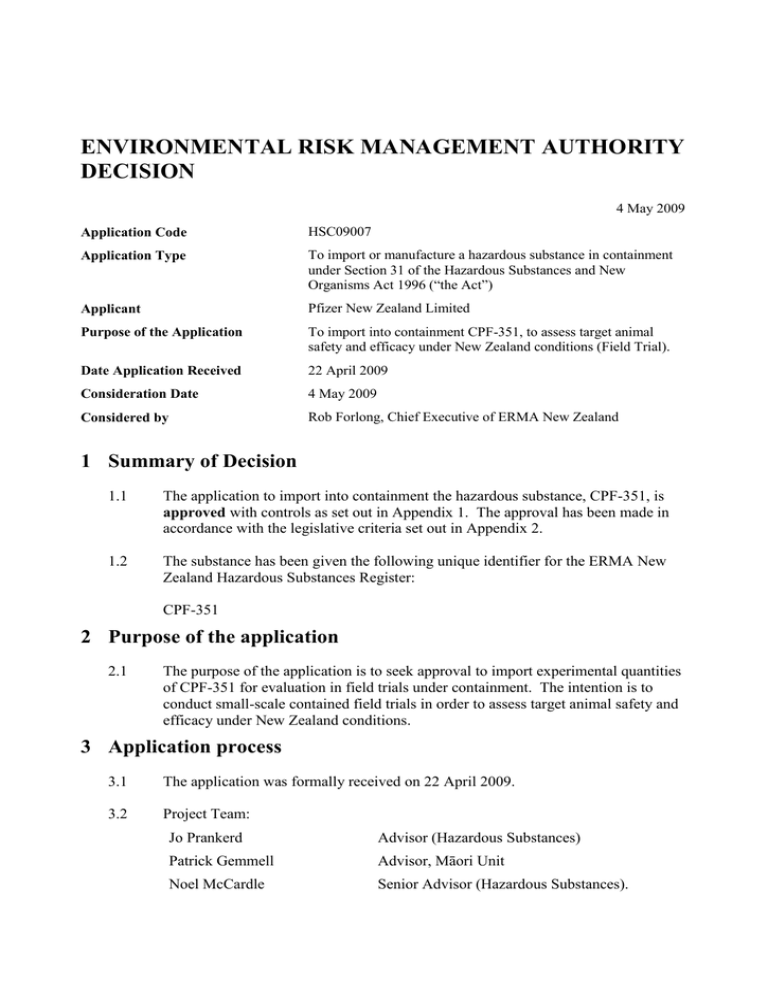
ENVIRONMENTAL RISK MANAGEMENT AUTHORITY DECISION 4 May 2009 Application Code HSC09007 Application Type To import or manufacture a hazardous substance in containment under Section 31 of the Hazardous Substances and New Organisms Act 1996 (“the Act”) Applicant Pfizer New Zealand Limited Purpose of the Application To import into containment CPF-351, to assess target animal safety and efficacy under New Zealand conditions (Field Trial). Date Application Received 22 April 2009 Consideration Date 4 May 2009 Considered by Rob Forlong, Chief Executive of ERMA New Zealand 1 Summary of Decision 1.1 The application to import into containment the hazardous substance, CPF-351, is approved with controls as set out in Appendix 1. The approval has been made in accordance with the legislative criteria set out in Appendix 2. 1.2 The substance has been given the following unique identifier for the ERMA New Zealand Hazardous Substances Register: CPF-351 2 Purpose of the application 2.1 The purpose of the application is to seek approval to import experimental quantities of CPF-351 for evaluation in field trials under containment. The intention is to conduct small-scale contained field trials in order to assess target animal safety and efficacy under New Zealand conditions. 3 Application process 3.1 The application was formally received on 22 April 2009. 3.2 Project Team: Jo Prankerd Advisor (Hazardous Substances) Patrick Gemmell Advisor, Māori Unit Noel McCardle Senior Advisor (Hazardous Substances). 3.3 The applicant supplied the following documents: the application; confidential appendices containing formulation details and hazard information. 3.4 The following Government departments were advised of the receipt of the application and given the opportunity to comment: the Department of Labour (Workplace Group); the New Zealand Food Safety Authority (Agricultural Compounds and Veterinary Medicines Group (ACVM Group)). 3.5 No responses were received. 3.6 The applicant was provided with a copy of the proposed controls for CPF-351 and given the opportunity to comment on them. The comments provided were taken into account in the setting of controls. 4 Consideration Eligibility 4.1 As the purpose (see section 2.1) amounts to “research and development on any hazardous substance”, the Project Team considers that the application qualifies for consideration under section 30(ba). Lifecycle 4.2 The applicant is seeking approval to import 10 L of CPF-351 over the period of the field trials. This will allow administration of the product to approximately 200 sheep and 100 cattle, using a fresh bottle at each study. 4.3 CPF-351 will be imported into New Zealand via air or sea freight in 500 ml glass bottles. On arrival into New Zealand, the substance will be immediately transported by road to the location of the clinical trial site. Transportation will comply with the relevant New Zealand transport legislation. CPF-351 will be securely packed in containers and identified in accordance with the Hazardous Substances (Identification) Regulations 2001. 4.4 CPF-351 is a veterinary medicine and will be used by, or under the supervision of a registered veterinarian. The substance will be administered to the animals by needle and syringe. The study investigator will keep a log of the amount of substance used. 4.5 The substance will be stored at the trial sites in accordance with the Code of Practice for the Management of Agrichemicals NZS8409:2004 and the relevant storage requirements of the Act and the Resource Management Act 1991. 4.6 The applicant indicates that the substance will be disposed of by use. However, any unused substance will be returned to Pfizer New Zealand’s warehouse, where it will be securely stored until disposal. The applicant notes that disposal of excess product will be undertaken by approved means. ERMA New Zealand Decision: Application HSC09007 Page 2 of 11 Hazardous properties 4.7 The Project Team notes that a containment application only requires sufficient understanding of the hazardous properties of the trial substance to ensure that any risks can be managed by the containment controls. 4.8 It is also noted that the scope of the hazard information will often be limited for containment applications, as the substance for which the approval is sought is experimental. 4.9 The applicant considers that CPF-351 has toxic and ecotoxic properties; however, it is not explosive, flammable, an oxidiser or corrosive. 4.10 The Project Team has reviewed the summary data and other information supplied by the applicant and considers that the information is sufficient to determine that any risks posed within the defined lifecycle of the substance in New Zealand can be managed through the application of controls. Identification and evaluation of the significant risks of the substance in containment 4.11 The applicant has identified and assessed potential risks and detailed proposals for, and impacts of, risk management. The Project Team has evaluated the applicant’s assessment of the risks to the environment, human health and Māori issues and concerns as set out below: Risks to the environment 4.12 If released into the environment the substance has the potential to cause adverse effects. 4.13 On the basis of the lifecycle of the substance, adverse environmental effects could arise from: an accident during importation, storage, use or transportation, resulting in release of the substance; failure to follow the correct operational procedures as set out in the controls, resulting in release of the substance; or failure to follow correct disposal procedures. 4.14 The Project Team notes that a limited quantity of the substance will be imported (up to 10 L) and released into containment for field trials, which are to be conducted over a limited period of time. 4.15 The Project Team considers that, taking into account the hazardous properties of the substance, the limited quantity involved, the containment controls in Appendix 1 and controls in place under other legislation, there are no significant risks to the environment from these trials. ERMA New Zealand Decision: Application HSC09007 Page 3 of 11 Risks to human health 4.16 The Project Team considers that adverse effects to human health may result from exposure to CPF-351. 4.17 On the basis of the lifecycle of the substance, adverse effects could arise from: an accident during importation, storage, use or transportation, resulting in release of the substance; failure to follow the correct operational procedures as set out in the controls, resulting in personnel exposure while contained, or bystander exposure if released; or failure to follow correct disposal procedures. 4.18 Taking into account the quantity of substance involved in the trials, and the containment regime proposed by the application, and the containment controls proposed in Appendix 1, the Project Team considers that there are no significant risks to human health. Māori issues and concerns 4.19 The Project Team has considered this application in accordance with clauses 9(b)(i) and 9(c)(iv) of the HSNO (Methodology) Order 1998 (“the Methodology”) and sections 6(d) and 8 of the Act. In addition, the Project Team used the framework contained in the ERMA New Zealand user guide “Working with Māori under the HSNO Act 1996” to assess this application. 4.20 The Project Team assessed the potential for adverse effects to the relationship of Māori to the environment taking into account the nature of the substance and the application of appropriate controls. The Project Team notes that this application covers the import of a compound that is likely to trigger a number of hazard classifications, giving rise to the potential for cultural risk including the deterioration of aquatic taonga flora and fauna species, the environment and the general health and well-being of individuals and the community. 4.21 Taking into account the containment measures proposed, the Project Team considers any likely impact of the substance on Māori culture or traditional relationships with their ancestral lands, water, sites, waahi tapu, valued flora and fauna and other taonga to be negligible. In addition, because of the nature of the testing regime there is no evidence to suggest that the controlled use of this substance will breach the principles of the Treaty of Waitangi or inhibit the ability of iwi/ Māori to fulfil their role as kaitiaki. Consequently, there is no requirement for the applicant to consult with Maori regarding this application. This assessment is made on the condition that the substance is handled, stored, transported, used and disposed of, in accordance with the controls. 4.22 However, should inappropriate or accidental use, transport or disposal of the substance result in the contamination of waterways, it is suggested that the applicant notify the appropriate authorities including the relevant iwi authorities in the region. This action should include advising them of the contamination and the measures taken in response. ERMA New Zealand Decision: Application HSC09007 Page 4 of 11 5 Containment and controls 5.1 The Project Team has evaluated the adequacy of the containment arrangements proposed by the applicant in the application and the controls listed in Appendix 1, and notes that these cover the matters set out in Part 3 of the Third Schedule of the Act, being: to limit the likelihood of escape of any contained hazardous substance or contamination by hazardous substance; to exclude organisms from a facility; to exclude unauthorised people from the facility; to prevent unintended release of the substance by experimenters working with the substance; to control the effects of any accidental release of the substance; inspection and monitoring requirements; and qualifications required of the person responsible for implementing the controls. 6 Conclusion 6.1 I have considered this application made under section 31 and, pursuant to section 32, I am satisfied that this application is for the purpose specified in section 30(ba), namely research and development on any hazardous substance. 6.2 Having considered the risks associated with the lifecycle of CPF-351, I am satisfied that the controls imposed, including those in place under other legislation, will result in the substance being adequately contained. 6.3 The application to import into containment the hazardous substance CPF-351 is thus approved with controls in accordance with the relevant provisions of the Act and the Methodology as more specifically set out in Appendix 2. Rob Forlong Date: 4 May 2009 Chief Executive of ERMA New Zealand ERMA New Zealand Approval Code: CPF-351 ERMA New Zealand Decision: Application HSC09007 HSC000370 Page 5 of 11 APPENDIX 1: LIST OF CONTROLS THAT APPLY TO CPF-351 General requirements and restrictions 1. This approval covers the contained importation and trialling of the substance identified as CPF-351, as notified to ERMA New Zealand pursuant to Control 4. 2. The maximum quantity of CPF-351 that may be imported under this approval is 10 L. 3. This approval remains in place for the term of any concurrent approval required under the Agricultural Compounds and Veterinary Medicines Act 1997, to a maximum of five years. 4. Each study protocol, both that of the Proof of Concept Study as well as the protocols under the subsequent Development Programme, containing the location, start and completion of the trials must be notified to ERMA New Zealand and the Department of Labour [Attn. HSNO Project Manager (Workplace Group) or equivalent position] prior to the use of CPF-351 in a field trial. The notification shall include: - a Project Plan for the trial, containing information as specified in Appendix 1.2; a Safety Data Sheet; and the following identifying details: ERMA Application number HSC09007 Substance name/code CPF-351 ERMA Approval number HSC000370 ERMA Applications Advisor Jo Prankerd Packaging and Information 5. The substance shall be securely packed in suitable containers that comply with the Hazardous Substances (Packaging) Regulations 2001. 6. Packages shall be labelled in accordance with the Hazardous Substances (Identification) Regulations 2001. 7. A Safety Data Sheet, compliant with the Hazardous Substance (Identification) Regulations 2001, shall accompany each shipment of the substance and be held at the trial sites for the duration of the application. Storage 8. CPF-351 shall be securely stored in accordance with the Code of Practice for the Management of Agrichemicals NZS 8409: 2004. ERMA New Zealand Decision: Application HSC09007 Page 6 of 11 Transport 9. The substance shall be transported in compliance with any relevant requirements of the Land Transport Rule: Dangerous Goods 2005, the Civil Aviation Act 1990 or the Maritime Transport Act 1994. General handling of the substance 10. Appropriate Personal Protective Equipment (PPE), for example, safety glasses, gloves and protective clothing shall be worn when handling the substance, for example during handling, application and disposal. Trial Sites 11. The trials may be carried out at a location that is not defined prior to approval, provided the applicant: a. has written permission from the owner of the land to carry out the trial; and b. notifies ERMA New Zealand in writing of the location in accordance with Control 4. Access to the trial sites shall be by permission of the Trial Director1, nominated researcher or owner of the property on which it is located. 12. Trial Conditions 13. The trials shall be undertaken in accordance with the information provided in the application and the Project Plan which accompanies the notification of each field trial. Modifications to information provided in the application may only be made with the prior written approval of ERMA New Zealand and must be in compliance with the controls specified in this document. 14. The personnel applying the substance shall be able to demonstrate that they have the qualifications necessary to carry out the trial, for example, by being a trained veterinarian or suitably trained person. For each trial, experimental staff shall be made aware of the trial protocol, the Project Plan, and the controls in place in order to adequately manage the substance. 15. The substance shall be mixed, diluted, prepared or otherwise prior to application in accordance with good practice. This may be demonstrated by compliance with the Code of Practice for the Management of Agrichemicals NZS 8409: 2004. 16. Only the quantity of the substance that is sufficient to treat the designated animals in the study shall be taken to the study site. 17. CPF-351 shall be applied directly to animals using standard equipment for the method of administration. Such equipment shall be suitably calibrated to deliver an accurate dose rate. CPF-351 shall be administered at the dose rates and in the manner approved by the ACVM Group, NZFSA, where these have been specified as part of the registration. 1 The Trial Director is the individual appointed by the applicant to be responsible for the overall conduct of the trial in accordance with the approval controls. ERMA New Zealand Decision: Application HSC09007 Page 7 of 11 18. Administration of the substance to trial animals shall take place in accordance with good veterinary practice. This would generally be achieved through compliance with the Code of Practice for the Management of Agrichemicals NZS8409:2004. Trials shall be conducted in such a way as to prevent the substance entering surface water or ground water system. 19. The population of the trial animals shall be marked in a manner such that treated animals may be clearly identified and be distinguished from untreated animals. 20. Treated animals shall be confined in the trial area as defined in the provisional registration to be issued by the ACVM Group, NZFSA. 21. The produce from any treated animal intended for human or animal consumption, or offered for sale shall comply with any withholding period and maximum residue levels (MRLs) set by the ACVM Group, NZFSA. 22. Documentation shall be kept that records the quantities of the substance imported, manufactured, administered, stored and ultimately destroyed. The records of use shall cover all matters referred to in Regulation 6(1) of the Hazardous Substances (Classes 6, 8, and 9 Controls) Regulations 2001 and must be kept for not less than 3 years after the date on which the substance that the record applies to is applied. 23. Any equipment used during administration shall be disposed of, or treated with an appropriate detergent or decontaminant until rendered non-hazardous, and the rinsate disposed of according to the disposal provisions of the Hazardous Substances (Disposal) Regulations 2001. Emergency Management 24. Any spillage of the substance (diluted or not) shall be contained, prevented from entering water bodies, and be absorbed with an appropriate absorbent material. The absorbent material shall be collected and placed in sealed containers for disposal at an appropriate waste disposal facility (which may include a landfill), subject to the facility’s waste acceptance policy. Disposal 25. Any surplus substance remaining at the end of the trials2 shall be returned to Pfizer New Zealand Limited until disposed of. Surplus substance shall ultimately be treated in a manner to render the substance, as a whole, non-hazardous or be exported from New Zealand. Disposal shall be carried out in a manner compliant with the Hazardous Substances (Disposal) Regulations 2001. 26. Containers no longer used to contain the substance and residue or rinsate from equipment used to handle the substance shall be disposed of in a manner compliant with the Hazardous Substances (Disposal) Regulations 2001. 2 The end of the trials is considered to be the end of the trial programme as defined in the Project Plan for each substance. ERMA New Zealand Decision: Application HSC09007 Page 8 of 11 Notification and Inspection 27. If for any reason a breach of containment occurs, the Trial Director shall notify the Department of Labour and ERMA New Zealand within 24 hours of the breach being detected. It is suggested that if a breach in containment results in contamination of a waterway, the relevant iwi authorities be advised. 28. The Authority or its authorised agent or properly authorised enforcement officers, may inspect the facilities and trial sites at any reasonable time. Trial documentation, as described in Control 4, notwithstanding its confidential nature, shall be available for inspection by any enforcement officer, upon request. ERMA New Zealand Decision: Application HSC09007 Page 9 of 11 APPENDIX 1.2: CONTENTS OF PROJECT PLAN The Project Plan to be supplied shall contain information on the following points: 1) 2) 3) 4) 5) 6) 7) 8) 9) 10) 11) 12) Direction, including identification of the Study Director Unequivocal identification and quantity of substance Project title Purpose Trial location/s (address and contact details) The security systems and containment provisions specific to the location A copy of the trial protocol (or study plan) Trial dates (start and completion) Number and species of trial animals Application method, application period, and dose rate Fate of treated animals and any produce from those treated animals Withholding period (where appropriate) ERMA New Zealand Decision: Application HSC09007 Page 10 of 11 APPENDIX 2: LEGISLATIVE CRITERIA FOR THE APPROVAL A2.1. Unless otherwise stated, references to section numbers in this decision refer to sections of the Act and references to clauses refer to clauses in the Methodology. A2.2. The application was lodged pursuant to section 31. The decision was made in accordance with section 32, taking into account additional matters to be considered in that section and matters specified under Part II of the Act (including the Methodology) and the provisions of Part III of the Third Schedule of the Act. A2.3. Government departments with an interest in this type of application were advised of the receipt of the application in accordance with clause 2(2)(e). A2.4. This application was considered by the Chief Executive of ERMA New Zealand under delegation from the Authority (section 19(2)(e)). A2.5. In accordance with section 32, the approach adopted when considering this application was to confirm whether the application was for one of the purposes specified in section 30, to identify and assess the risks (Clauses 9, 12, 13, 14, 22, 24, 25) and to determine whether the substance could be adequately contained by controls to provide for each of the matters specified in Part III of the Third Schedule of the Act. A2.6. In accordance with clause 36(2)(b), it is recorded that, in reaching his decision, the Chief Executive applied the criteria specified in section 32. A2.7. The Chief Executive also applied the following criteria in the Methodology: clause 11 – characteristics of substance; clause 21 – the decision accords with the requirements of the Act and regulations; clause 26 – all risks negligible; clause 35 – the costs and benefits of the controls. ERMA New Zealand Decision: Application HSC09007 Page 11 of 11



